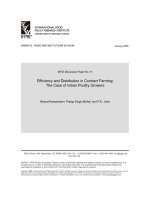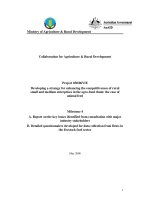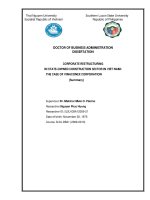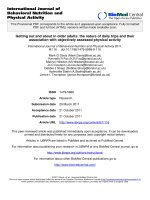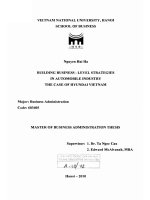Young people’s experience and perception in community violence the case of kebele 45, woreda 4, kirkossub city
Bạn đang xem bản rút gọn của tài liệu. Xem và tải ngay bản đầy đủ của tài liệu tại đây (1.09 MB, 90 trang )
0
Running Head: Young Peoples Experience And Perception...
Young people’s experience and perception in community violence: The Case of Kebele
45, Woreda 4, KirkosSub City
By:
SelamawitYinessu
Addis Ababa University
Addis Ababa, Ethiopia
June 2017
0
Running Head: Young Peoples Experience And Perception...
Young people’s experience and perception in community violence: The Case of Kebele
45, Woreda 4, KirkosSub City
By: SelamawitYinessu
A Thesis proposal submitted to
The School of Social Work
Presented in Partial Fulfillment of the Requirement for the Degree of Masters in Social
Work
Advisor: WassieKebede (Ph.D)
Addis Ababa University
Addis Ababa, Ethiopia
June 2017
0
Running Head: Young Peoples Experience And Perception...
Declaration
I, the undersigned, declare that this thesis is my original work and has not been
presented for degree in any other University and that all sources of materials used for this
thesis have been duly acknowledged.
Name: ___________________________ Signature: ________________
Place: _____________________________ Date of Submission: ___________________
This thesis has been submitted for examination with my approval as a university advisor.
Name of Advisor: __________________________
Signature: _________________ Date: ___________________
0
Running Head: Young Peoples Experience And Perception...
Addis Ababa University
School of Graduate Studies
Thesis Approval
This is to certify that the thesis prepared by SelamawitYinessuentitle:The Experience
and Perceptions of Community Violence Among Young People: The Case of Kebele 45,
Woreda 4, Kirkos Sub City, submitted in partial fulfillment of the requirements for the
Degree of Master of Arts in Social work complies with the regulations of the University
and meets the accepted standards with respect to originality and quality.
Signed by the Examining Committee
Advisor _____________________ Signature _________ Date ________
Examiner ____________________Signature__________ Date_________
Examiner ____________________Signature__________ Date_____
0
Running Head: Young Peoples Experience And Perception...
Table of Contents
Acronym
i
Acknowledgment
ii
Abstract
iii
Chapter One: Introduction
Background of the study
1
Statement of the problem
3
Objective of the study
5
Research question
6
Significance of the study
6
Operational definitions
6
Chapter Two: Literature Review
General overview
7
Impact of exposure to Community violence
8
Experience and Perception of community violence
10
Intimate Partner violence as a sub-component of community violence
13
Community violence in regards to Africa
Intervention on Community Violence
Conceptual Framework
14
15
17
Chapter three: Methodology
Research Design
18
Methodological consideration
19
Description of the study area
20
1
Running Head: Young Peoples Experience And Perception...
Sampling Method
Sample Size
Data collection Tools
Qualitative data collection tool
Survey questionnaire
20
21
23
24
25
Data collection procedure
25
Data analysis Method
26
Ethical consideration
27
Chapter Four: Findings
Socio-demographic profiles of participants
28
Factors indicating community violence
30
Defining Community Violence
35
Young people and government officials around community violence
Perceived Risk Factors
Perceived Outcomes of community violence by young people
37
41
48
Personal emotional outcome
48
Community outcome
49
Community violence intervention strategies49
Chapter Five: Discussion
53
Chapter Six: Conclusion, Recommendation and Social Work Implication
58
References
Appendix:IConsent Form
Appendix: II In Depth Interview Guide for young people who live in Kebele45
2
Running Head: Young Peoples Experience And Perception...
Appendix: III Interview Guide for police officers (Key Informants)
Appendix: IV Interview Guide for Kebele Key Informants
Appendix: V Focus Group Discussion Points
Appendix: VI Questionnaire guide
Appendix : VIIHeavy crimes committed during 2007 and 2008 according to
LematKetena police report when compared and described
i
Running Head: Young Peoples Experience And Perception...
Acronyms
BCS- British crime survey
CVE- Community violence exposure
DHS-Demographic and Health surveys
ETB-Ethiopian birr
FGD-Focus group discussion
GBV-Gender based violence
IPV- Intimate partner violence
MEPS-means-ends problem-solving
NIPV-Network intimate partner violence
PSTD- Post traumatic stress Disorder
PTS- Post traumatic stress
UNICEF-United Nations International Children’s Emergency Fund
VPUU-Violence Prevention through Urban Upgrading project
WHO- World Health Organization
ii
Running Head: Young Peoples Experience And Perception...
Acknowledgements
It would be impossible to acknowledge all of the individuals who have encouraged,
inspired and collaborated on the progress of my study. Nonetheless, some people to
whom I owe a particular debt of gratitude need to be specifically acknowledged. First of
all I am grateful to my advisor Dr. WassieKebede for his constructive comments and
guidance’s throughout this research. My deepest gratitude also goes to all the participants
of the study for their unreserved cooperation during data collection. Thank you all!!
iii
Running Head: Young Peoples Experience And Perception...
Abstract
This research tried to explore and describe young people’s experience and perception in
community violence in Woreda 4, Kebele 45 of Kirkos Sub-city. This area was selected
because of the prevalence of different kind of violent crimes than the rest of the kebeles in
the sub city. The rational of this study is that, there is no research done in the area under
study that focuses on young people’s experience and perception in community violence.
The objective to achieve in trying to explore and describe young people’s experiences
and perceptions in community violence was by identify young individual’s perception
about risk factors of community violence and to identify community violence intervention
strategies from the perspective of young people. The study used a mixed methods
research applied a concurrent design, the selected study design in this study gives a
QUALITATIVE-quantitative weight and a concurrent (time-wise) nested mixed design.
For the qualitative method used a case study design and the quantitative method used a
survey design. For the survey a sample size of 265 was taken from a population of 850.
While purposive sampling was used in the process of selecting participants in the
qualitative data so as to reach specific group of people such as young people who are
victims of different kinds of crimes and young people that are residents of the area in
general. A maximum of 7 participants was taken for the collection qualitative data. For
the qualitative study, the data collection techniques used include; in-depth interviews
with participant, key-informant interviews, FGD and observation. A survey questionnaire
was designed and employed to collect quantitative data. A concurrent mixed analysis was
utilized to analyze the qualitative and quantitative data. The result confirmed that most of
the young people in the community have unstable economic status. Unemployment was
found to be the major factor which leads the young people to commit violent acts.
Majority of the respondents claimed that victims prefer to report their cases relatives,
friends and significant others rather than reporting to the police. Four areas of risk
factors of community violence identified in this research include community factors,
family factors, and relationships with peers, and personal characteristics.The study
revealed that in majority of the cases perpetrators are peers of the victims. Several
personal level emotional responses were identified by young people as outcomes of
community violence. In addition to the personal level emotional responses, five
community level outcomes were documented. The study also revealed seven key areas for
intervention. In conclusion unemployment is one of the leading problems in the
community. Young people in the community have different unmet needs and are
particularly at risk of participating in problem behaviors. Young people who have the
most severe unmet needs in their lives are particularly in jeopardy of participating in
violent behavior. The issue of community violence in many occasions, the responsibility,
resides on immediate families, the community and the society at large. Even though, some
of the youth accept on the progress, most of them believe that there could have been a
better result if the government works in closer ties with them. Hence, more work should
be done in this regard to improve the situation. Based on the finding this study
recommends that policies and programs be devised and implemented by concerned
organizations, more research should be done in regards to tackling unemployment in the
area and education and training should be done to address employment opportunities
and concealing overcoming their addictions to different substances.
Key Words: Young people, community violence
1
Running Head: Young Peoples Experience And Perception...
Chapter One: Introduction
Background of the study
We can define community violence more broadly as violent acts committed against
one person that have the potential to impact the community (Hamblen&Goguen, 2016).
Community violence is recognized as a major public health problem (WHO, 2002). As
stated by Reza, Krug, Mercy (2001), the main actors of community violence are young
people who are both the victims and perpetrators. Exposure to community violence is
among the most detrimental experiences children can have, impacting how they think,
feel and act (Richters& Martinez, 1993). As stated by United States Department of
Health and Human Services (2001)the experiences of the young people during their
childhood could be determining their engagement in violence as well and this exposure to
violence is defined as the vicarious experience of violence (e.g., hearing about violence),
being the direct victim of a violent act, or witnessing violence involving others.
Adolescents living in urban communities, marked by poverty, crime, and drug-related
activities, are often at increased risk for violence exposure and victimization (United
States Department of Health and Human Services, 2001). Youth violence deeply harms
not only its victims, but also their families, friends and communities. Violence involving
young people greatly undermines the fabric of society. Violent young people tend to
commit a range of crimes. They also often display other problems, such as truancy and
dropping out of school, substance abuse, compulsive lying, reckless driving and high
rates of sexually transmitted diseases, however, not all violent youths have significant
problems other than their violence and not all young people with problems are
necessarily violent (United States Department of Health and Human Services, 2001)
2
Running Head: Young Peoples Experience And Perception...
As stated byBuka, Stichick, Birdthistle, and, Earls, (2001), exposure to community
violence is an all too common occurrence among urban adolescents. Studies have
consistently documented the connection between exposure to community violence and
adolescents’ psychological and behavioral problems (Buka et al., 2001; Bingenheimer,
Brennan, & Earls, 2005; Margolin&Gordis, 2000). McGill, Brown, Lai, Osborne, Tiwari,
LeBlanc and Kelley, (2014), also states adolescents who are exposed to violence during
childhood are at an increased risk for developing posttraumatic stress (PTS) symptoms.
It is also unfortunate that in many cultures in Ethiopia, violence is also involved in
disciplining children and often their views areignored (Africa Child Policy Forum,
2006).As notedby DuRant, Cadenhead, Pendergrast, Slavens, and Linder, (1994),
exposure to violence is a strong predictor of delinquent behavior.
According to the police reports and information from both the community members
and Woreda 4administration office the young people that are currently situated in Addis
Ababa, Woreda 4, Kebele 45 also known by its unique name “Enat” are highly exposed
to different kinds of violence ranging from attempted murder to petty theft that occur
within their community. According to the views of some police person’s, it’s true a
decade ago crimes whereworse than they aretoday in this area but when looking at recent
reports it indicates a rising number of crimes committed by young people.
During my several encounter with the young people living in Kebele 45, I observed
that most of them lurked around smoking, chewing chat, sitting around insulting who
ever passes by them. But knowing what the inner cause of this young people in regards to
their experience and perceptions of community violence will help researchers and other
3
Running Head: Young Peoples Experience And Perception...
professionals to develop an intervention strategy.Hence, this study focused onthose
young people aged 18-24 and explored and describedthe experiences and perception of
community violence in the study site.
Statement of the problem
Community violence is a common occurrence all around the world and young
people’s experiences and perceptions vary from one community to the other even if there
maybe similarities. There are varietiesof researches conducted on the subject of
community violence among young people. These researches are studied by different
scholars, medical and social departments of different universities, hospitals and
institutions. Among those, Smith &Tolan (1998) examinesthe role of exposure to
community violence and developmental problems among inner-city youth.Buka et al,
2001),examines youth exposure to violence and its Prevalence, risks, and consequences.
Similarly, McGill, et al, 2014, examines the effects of exposure to community violence
and family violence on school functioning problems among urban youth.Kelly,
(2010),examines the psychological consequences to adolescents of exposure to gang
violence in the community. The study shows adolescents develop internalizing symptoms
and externalizing behaviors after exposure to violence; but other factors influence
adolescents’ exposure and reaction to violence such as their relationship with their
parents.
Community violence has been seen in relation to its effects from several angels
(Quille, Griffin, Stuart, Bradshaw, and Holden, 2009), studied on community violence
and youth in regards to affect, behavior, substance use, and academics. Moreira et al.,
2008),examine community violence and alcohol abuse among adolescents.Eitle&Turner
4
Running Head: Young Peoples Experience And Perception...
(2002), examines the exposure to community violence and young adult crime: The effects
of witnessing violence, traumatic victimization, and other stressful life events. This study
shows that recent exposure to violence in the community along with a history of
receiving traumatic news, direct victimizations in the community, recent life events, and
associations with criminal peers increase the risk for young adult criminal offending.
Anderson &Kidd (2014) studied the perceptions of community safety on the exposure
to community violence in a low risk Australian population. The finding shows that males
exposed to high levels of community violence were significantly more likely to perceive
their community as unsafe compared to males exposed to lower levels of violence. In
contrast, females who had been exposed to higher levels of community violence did not
perceive their community to be less safe. Moreover, while females were more likely to
perceive they had social support, there was no evident relationship between social
support and community safety for either females or males in the studied group.
Grossman &Sharples (2010) examines young people’s perspective on community
safety and policing which regards to how young people defined ‘safety’ which was as the
absence of anxiety when walking around the street or neighborhood; not feeling that they
were in danger, and not needing to be vigilant about security.
Even if, there are a handful of studies on the experiences and perception of community
violence among young people, there exists limited literature in Ethiopian context and
more specifically in the area that the research is conducted.While reviewing these
literatures it helped me view the importance of knowing the young people’s experience
and perception in community violence in order to implement appropriate intervention
strategies and reduce community violence.The rational of this study is that, there is no
5
Running Head: Young Peoples Experience And Perception...
research done in the area under study that focuses on young people’s experience and
perception in community violence particularly in the area under study. The focus of these
researches done cannot represent the case of young people found in urban Ethiopian
community because the experiences and perception of individuals across different nations
varyeven if there may be similarities. The strategies that can be used to intervene should
come in light of the different conditions (socio-demographic characteristics etc.) of the
study area that the individuals under study are undergoing. Hence, further research should
be done in this chosen study area in regards to the experience and perception of
community violence, perceived risk factors and intervention strategies among young
people in the community. Furthermore, keeping in mind the crime report in 2007 and
2008 by the police, I found Kebele 45 to be an appropriate place to explore and describe
the experience and perception of community violence among young people to meet the
objective of the study since there was a wider range of violent crimes that are being
committed in this community than the rest.
Objective of the study
General objective
The general objective of this research is to get a clear idea on the experience and
perception of young people about community violence
Specific objectives
Based on the general objectives this research will have three specific research
objectives
To explore and describe the experiences and perceptions of community
violence among young people.
6
Running Head: Young Peoples Experience And Perception...
Identify young individual’s perception about risk factors of community
violence.
To identifycommunity violence interventionsstrategies from the perspective of
young people.
Research question
This research will address three questions which are;
What is the experience and perceptions of community violence among young
people?
What are the perceived risk factors of community violence by young people?
What are community violence intervention strategies that can be identified from
the perspective of young people?
Significance of the study
The research is believed to assist governmental and non-governmental organizations
working on youth to adjust their intervention strategies based on the findings of the study.
Furthermore, the study will serve as a tool for awareness creation about community
violence among youth. Above all it will help in social work and police practice,
especially for community policing.
Operational definitions
Community Violence:For the purpose of this study community violence will be defined
as; violence between people or groups who may or may not be known to each other
(strangers or acquaintances), which occurs generally (but not always) in a public
place.(Preventing Violence, 2005, pg. 8)
Young people: for this research, young people are those aged 18-24.
7
Running Head: Young Peoples Experience And Perception...
Chapter Two: Literature Review
General overview
According to Burrowes, (2016) violence is a social interference in the genetically
programmed feelings, thoughts, sensing and/or behavior of another organism. The
violence inflicted by human adults on themselves, each other and the Earth is an outcome
of the visible, invisible and utterly invisible violence inflicted on them as
children.Morrison, (2004) states thatcrime is associated with harm and violence; harm to
individuals, destruction of property, and the denial of respect to people and institutions.
According to Bronfenbrenner, (1979) ecological theories acknowledge that youth are
shaped by multiple processes that occur at various levels, including the micro level or
immediate environment (e.g., family, schools, and community) and the macro level (e.g.,
societal and cultural contexts). The UN youth proclamation, (1965) states that the main
cause of delinquency is societal background, unemployment and under employment
especially acute in ruler society it can appear as an unwelcome break up of their ambition
and desire.
When we came to community violence as a concept it applies not only to direct
personal exposure (happened to you), it also includes exposure through witnessing (saw it
happen to someone else) and vicarious (know someone it happened to) routes
(Foy&Goguen, 1998). Hamblen &Goguen, (2016) identified community violence as a
complex term that has been used to refer to a wide range of events including riots, sniper
attacks, gang wars, drive-by shootings, workplace assaults, terrorist attacks, torture,
bombings, war, ethnic cleansing, and widespread sexual, physical, and emotional abuse.
8
Running Head: Young Peoples Experience And Perception...
Impact of exposure to community violence
According to Strickland et al., 2009, academic difficulties, behavior problems, and
substance use are adverse outcome of chronic community violence exposure.Moreira et
al., 2008, stated that adolescents of both sexes who consume more alcohol are at greater
risk of suffering from community violence. In accordance with this McGill et al, 2014
and Fairbrook (2013) also explained that PTS symptoms potentially mediate the
relationship between violence exposure and school functioning problems across two
settings (community and home). An increased risk of PTSD and internalizing symptoms
were associated with CVE. According to Buka et al., 2001,males, ethnic minorities, and
urban residents are at increased risk for witnessing violence, and that higher rates of
PTSD, depression, distress, aggression, and externalizing behavior disturbances are
reported among those who witness violence. Degree of family conflict, domestic
violence, and family support were demonstrated to modify the impact of exposure to
violence.
Smith &Tolan (1998), states that exposure to community violence was related to
increases in aggressive behavior and depression over a 1-year period even after
controlling for previous status but the participants only included male who are in schools
hence lacked to address both genders even though it gave a comprehensive understanding
in this regards. In this note Guerra, Huesmann, &Spindler (2003), also describe that
witnessing community violence has an effect on children’s aggressive behavior through
both imitation of violence and the development of associated cognitions as children get
older. Hence it can be seen that as Gardner & Gunn (2009), state lower violent crime
9
Running Head: Young Peoples Experience And Perception...
rates explain inverse association between the variety of youth organizations available at
the neighborhood level and adolescents’ exposure to community violence.
According to Kelly, (2010), little research has focused on adolescents’ exposure to
gang violence and its effects on adolescents’ mental health. Adolescents develop
internalizing symptoms and externalizing behaviors after exposure to violence; but other
factors influence adolescents’ exposure and reaction to violence. Linder, Lambert
&Ialongo, (2010), identified three vulnerable classes, a moderate risk/medium protection
class, and a moderate risk/high protection class. The classes differentially predicted
depressive symptoms but not aggressive behavior for boys and girls. The class with the
highest community violence exposure also had the lowest self-worth. DuRant et al.,
1994), stated that self-reported use of violence was associated with exposure to violence
and personal victimization, hopelessness, depression, family conflict, previous corporal
punishment, purpose in life, self-assessment of the probability of being alive at age 25,
and age was higher among males. However, adolescents with a higher sense of purpose in
life and less depression were better able to withstand the influence of exposure to
violence in the home and in the community.
Reza, Mercy & Krug, (2001), stated that in 1990, an estimated 1,851,000 people died
from violence (35.3 per 100,000) in the world. There were an estimated 786,000 suicides.
Overall suicide rates ranged from 3.4 per 100,000 in Sub-Saharan Africa to 30.4 per
100,000 in China. There were an estimated 563,000 homicides. Overall homicide rates
ranged from 1.0 per 100,000 in established market economies to 44.8 per 100,000 in SubSaharan Africa with peaks among males aged 15–24 years old, and among females aged
0–4 years old. In contrast Eitle& Turner (2002) stated that exposure to violence in the
10
Running Head: Young Peoples Experience And Perception...
community along with a history of receiving traumatic news, direct victimizations in the
community, recent life events, and associations with criminal peers increase the risk for
young adult criminal offending.
Experience and Perception of Community Violence
Anderson & Kidd (2014), states that males exposed to high levels of community
violence were significantly more likely to perceive their community as unsafe compared
to males exposed to lower levels of violence. In contrast, females who had been exposed
to higher levels of community violence did not perceive their community to be less safe.
Moreover, while females were more likely to perceive they had social support, there was
no evident relationship between social support and community safety for either females
or males in the studied group. In accordance with this in a study done by Grossman
&Sharples (2010) young people defined ‘safety’ as the absence of anxiety when walking
around the street or neighborhood; not feeling that they were in danger, and not needing
to be vigilant about security. The main public places young people said were unsafe for
them were: train and bus stations; on public transport; walking down the street, and in
local parks. Young people overwhelmingly reported train and bus stations as more unsafe
than other areas. Rasmussen, Aber&Bhana (2004), explains that in low and medium
crime rate areas, using confrontive strategies was significantly correlated within increased
exposure to violence, and no strategies were associated with perceptions of safety.
Coping strategies were associated with perceived safety to a substantial degree only in
high crime neighborhoods, and none were associated with exposure to violence. It also
identified groups that differed in coping profiles and varied in rates of exposure to
11
Running Head: Young Peoples Experience And Perception...
violence. Moderating effects of gender, ethnicity, and neighborhood were found for both
person level and variable level analyses.
Howard, Kaljee&Jackson, (2002), state that although perceptions of safety varied
according to weapon-carrying/fighting status, staying locked inside one's home and
maintaining a vigilance when dealing with others were identified as primary protective
strategies. MEPS scores were not predictive of appraisal or coping processes. Youth were
not expressive about emotional distress aroused by exposure.
According to Smith & Green, (2007), oppressive environments are closely linked to
hostility and violence. Halsey & White, (2008), explains that while it’s generally
acknowledged that official crime statistics are subject to many inherent limitations, e.g.
changes to police recording practices and the absence of crimes unreported by the public.
Therefore, in order to shed light on the realities of youth crime, alternative sources of
information on youth offending behavior are essential. Although self-report studies have
been conducted, they have been done intermittently and therefore it is difficult to make
confident assertions about long-term trends in youth crime. The absence of corroboratory
evidence on youth crime means that it would be hard to evaluate the true impact of
strategies or policies that seek to address youth offending. A long-term, self-report
offending survey for young people along the lines of the BCS would make a valuable
addition to this analysis of criminal behavior.
According to Martin, Lang, Falsone, andO'Donoghue,(2007), risk factors associated
with ‘family and household’ and ‘relationships with parents / caregivers’ were considered
the higher risk factors by young people, general community and stakeholders likewise
risk factors associated with ‘community and neighborhood’, ‘personal risk factors’ and
12
Running Head: Young Peoples Experience And Perception...
‘relationships with peers’ were also, however, considered important. In general, this
research confirmed that other strategies will potentially have little effect if early
intervention strategies are not also put into place. Greater visibility of Police was
considered a key strategy for young people, stakeholders and the general community as a
proactive, rather than reactive, measure. School-based strategies and organized
community activities are also considered important. Structural strategies, particularly
increased lighting in dark areas, was considered important. Community violence is a high
concern to young people, general community and stakeholders. Behaviors that are of
concern include physical fighting, verbal abuse, graffiti / vandalism and intimidating
behavior. Situations that are of concern include evenings, weekends and more generally,
situations where you are ‘alone’. Specific locations that are considered a concern include
parks, shopping centers, public transport, night clubs / pubs and late-night fast food
outlets.
Friggieri, (2013), states young people seem to be fully aware that they are vulnerable
to violent relationships as more than 90% of them confirmed their exposure to such
behavior. Young people attribute violent relationships to low self-esteem (35%),
deserving to be mistreated, feeling emotionally numb and helpless and feeling afraid as
the other pre-dominant factors.
Pells, Portela&Revollo, (2016), state that bullying experienced in adolescence is
associated with negative psychosocial well-being in early adulthood Findings show that
better data collection and increased resource allocations to bullying prevention are
needed. The development and evaluation of different types of effective, sustainable and
13
Running Head: Young Peoples Experience And Perception...
scalable bullying prevention models in low- and middle-income country contexts are
priorities for programming and research.
Intimate Partner Violence as a sub-component of Community Violence
Abeya, Afework&Yalew, (2012), state that most discussants perceive, intimate partner
violence is accepted in the community in circumstances of practicing extra martial sex
and suspected infidelity. The majority of women are keeping silent and very few defend
themselves from the violent husband/partner. The suggested measures by the community
to stop or reduce were targeting actions at the level of individual, family, community, and
society. In light if this Raghavan, Mennerich, Sexton, and James (2006), also explains
that living in neighborhood with higher levels of social disorder and using substances
increased women’s exposure to community violence that, in turn, was associated with
increased rates of IPV. In addition, although not associated with community violence
NIPV was associated with increased IPV. The result suggests that examining
neighborhood level factors is important in domestic violence, policy, practice, and
research.
According to Semahegn&Mengistie, (2015), domestic violence against women was
relatively high in different parts of Ethiopia. Domestic violence has direct relationship
with socio-demographic characteristics of the victim as well as the perpetrator. Therefore,
appropriate health promotion information activities needed to tackle associated factors of
domestic violence against women or to prevent and control the problem to save women
from being victims.
Community violence in Africa
14
Running Head: Young Peoples Experience And Perception...
According to Baker & Ricardo (2005), changing gender norms is slow, and it is made
even slower by the fact that those who make program and policy decisions often have
their own deep-seated biases about gender and are frequently resistant to question those.
Ruto (2009), states that 58 of every 100 children have been sexually harassed while 29%
boys and 24% girls reported to have been forced into unwanted sex in Kenyan schools.
The main perpetrators of the violence were mentioned as peers while the home featured
as the most unsafe place. Similarly, Gender links, (2008), demonstrates that there is a vast
array of initiatives across the country, covering most but not all of the arenas for action
for ending GBV. While the examples cited in this chapter show many different attempts
to measure progress these are mainly short term and do not give a composite picture of
the impact of preventive efforts in the GBV sector. In contrast UNICEF, (2006), shows
that young people see what happens to girls in the face of violence and discrimination.
But they also suggest ways to change how girls are treated and see themselves as vital
part of the process. According to Borwankar,Diallo, Going, Sommerfelt, and, Oluwole,
(2009), domestic violence levels are high and deserve to be recognized as a development
priority in Africa.
Alemika&Chukwuma (2000), state police-community violence is facilitated in the
country by the frustration of citizens and police arising from inadequate transportation
and telecommunication facilities that militate against effective and timely communication
by distressed citizens with police and prompt response of the latter to citizen's call for
assistance. This in adequacy portrays the police as ineffective and the citizen as
unreasonable, thereby hardening mutual prejudice and hostility between the police and
citizens, which under certain conditions erupt into violence. Majority of the citizens lack
15
Running Head: Young Peoples Experience And Perception...
adequate knowledge of the role and powers of police. Therefore any action of the police,
even within law and which should elicit cooperation, is resented. In such situation, the
police may enforce the law using measures that would normally have been unnecessary.
According to OECD, (2011), the positive outcomes of VPUU are due to the
interaction between numerous committed stakeholders and an area-based approach, with
a major emphasis on community participation, social development, and operation
maintenance and management of spaces. In contrast, Leoschut&Burton, (2009), state
school environment gives rise to factors that have a diminishing effect on children’s
potential to commit crime.
Intervention on Community Violence
According to Bailey & Whittle (2004), the recent evidence base in the field of young
people as victims of violence is beginning to identify processes, mechanisms and
interventions that can start to counteract the damage done to the individual, families,
communities and generations of children
Ferdon&Simon, (2014) explained that everyone has a role to play in preventing youth
violence, it describes actions that young people, families, caregivers, adults who work
with youth, and other community members can take to reduce youth violence such as by
being a consistent model for how to respond nonviolently to conflict, stress, and
fear.Carefully monitor youth’s activities and behavior, helping youth make safe choices,
and talk with others who have a strong influence on young people. Building a connection
with young people that allows them to feel comfortable discussing violence and related
concerns are some of the roles that can be played to prevent youth violence.

